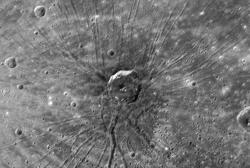
With Mercury fading in MESSENGER's rear view mirror, scientists are just starting to pore through the torrent of images sent back. And as you can probably guess, the new mysteries are piling up fast and furious. The planet is much less like the Moon than scientists previously thought.
MESSENGER made its closest approach to Mercury on January 14, passing just a few hundred kilometres above its surface. During the flyby it captured a total of 1,213 images.
One of the most unique features discovered by MESSENGER has been dubbed "The Spider" by scientists. And that's what it looks like. The feature has a central crater surrounded by more than a hundred narrow, flat-floored troughs (called graben) radiating away.
Unlike the Moon, Mercury has huge cliffs or scarps, which can snake hundreds of kilometres across the planet's surface. They trace the lines of old volcanic faults, from when the planet was still geologically active.
Because of its small size and high density, Mercury has a surprisingly large pull of gravity. Astronauts walking around its surface would experience 38% of the Earth's gravity. This higher gravity means that the impact craters look different. Material doesn't splash out from the impact craters so far, and there are many more secondary crater chains.
“We have seen new craters along the terminator on the side of the planet viewed by Mariner 10 where the illumination of the MESSENGER images revealed very subtle features. Technological advances that have been incorporated in MESSENGER are effectively revealing an entirely new planet from what we saw over 30 years ago,” said Science Team Co-Investigator Robert Strom, professor emeritus at the University of Arizona and the only member of both the MESSENGER and Mariner 10 science teams.
MESSENGER wasn't just taking pictures. It also had a suite of scientific instruments measuring many features of the planet. Perhaps the most puzzling of these is its magnetic field. Even though Mercury cooled down and solidified eons ago, it still has an magnetic field. This was first detected by Mariner 10, and MESSENGER confirmed it.
This is just the beginning. MESSENGER will return to Mercury on October 6, 2008 to make a second flyby, and then a third on September 29, 2009. The spacecraft make its final return to the planet on March 18, 2011 when it'll begin a year-long orbital mission.
Original Source: MESSENGER News Release



No comments:
Post a Comment